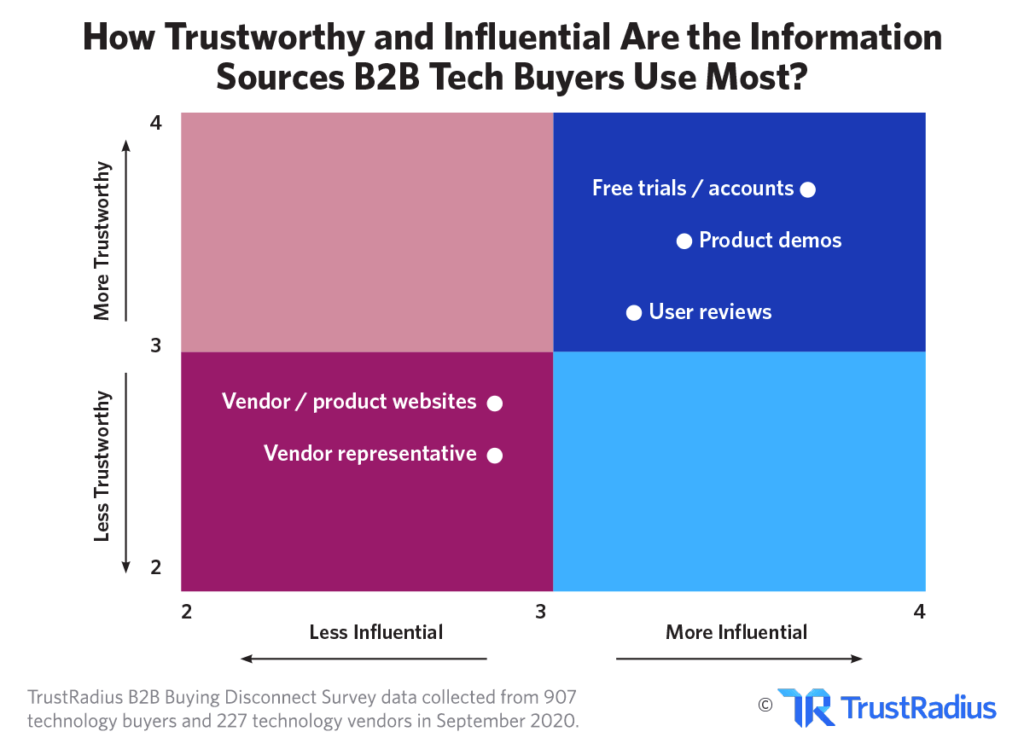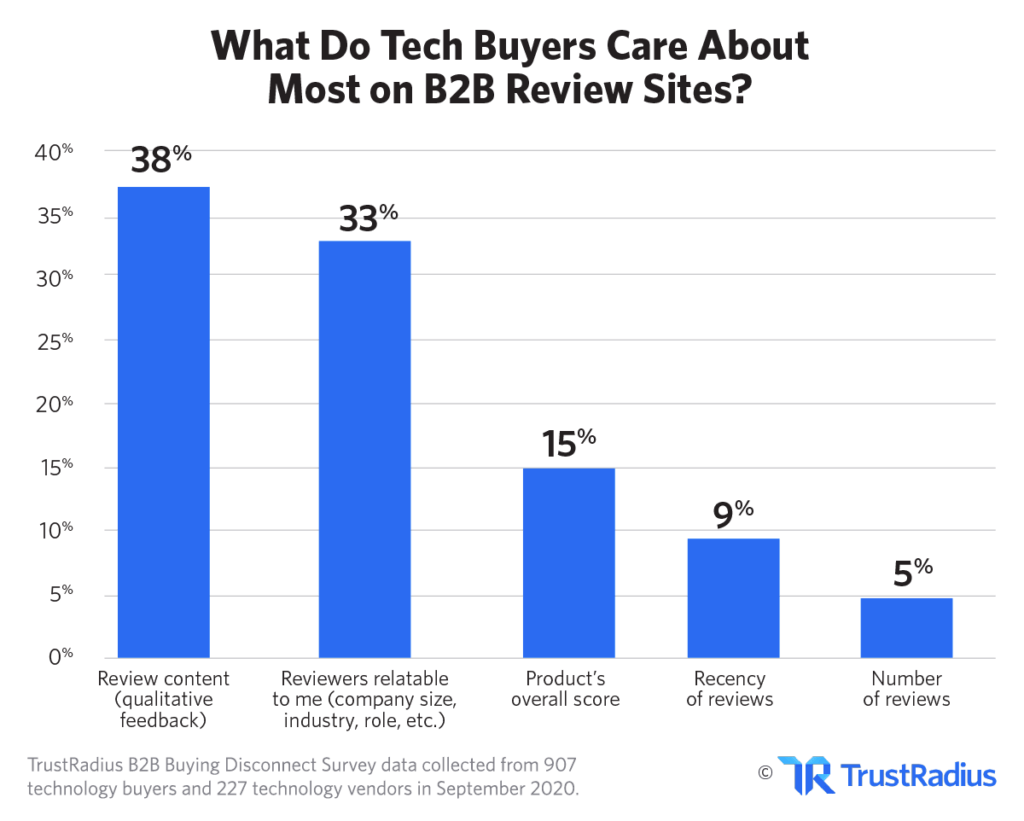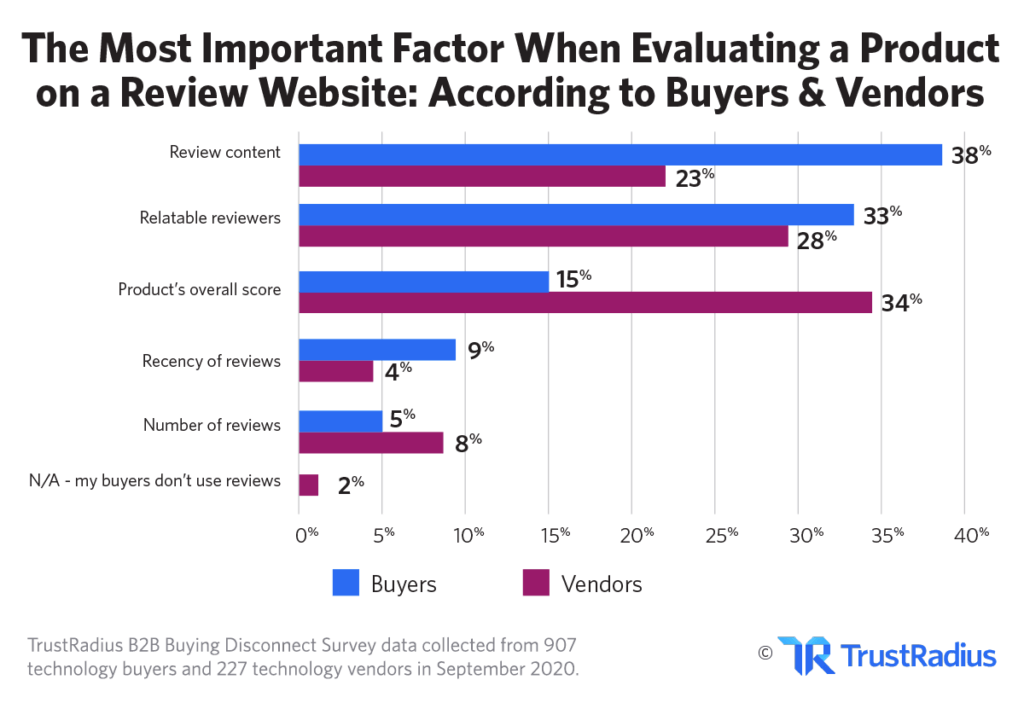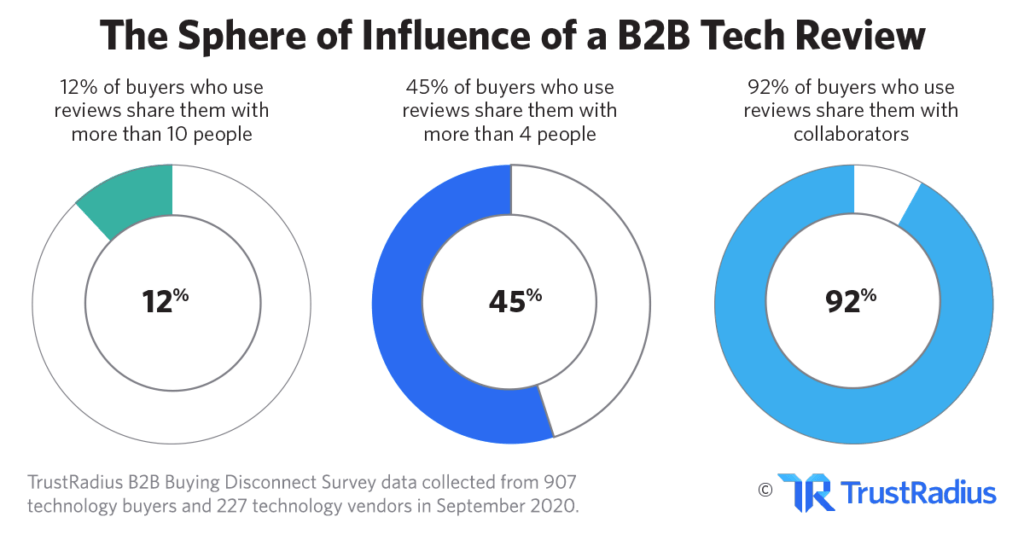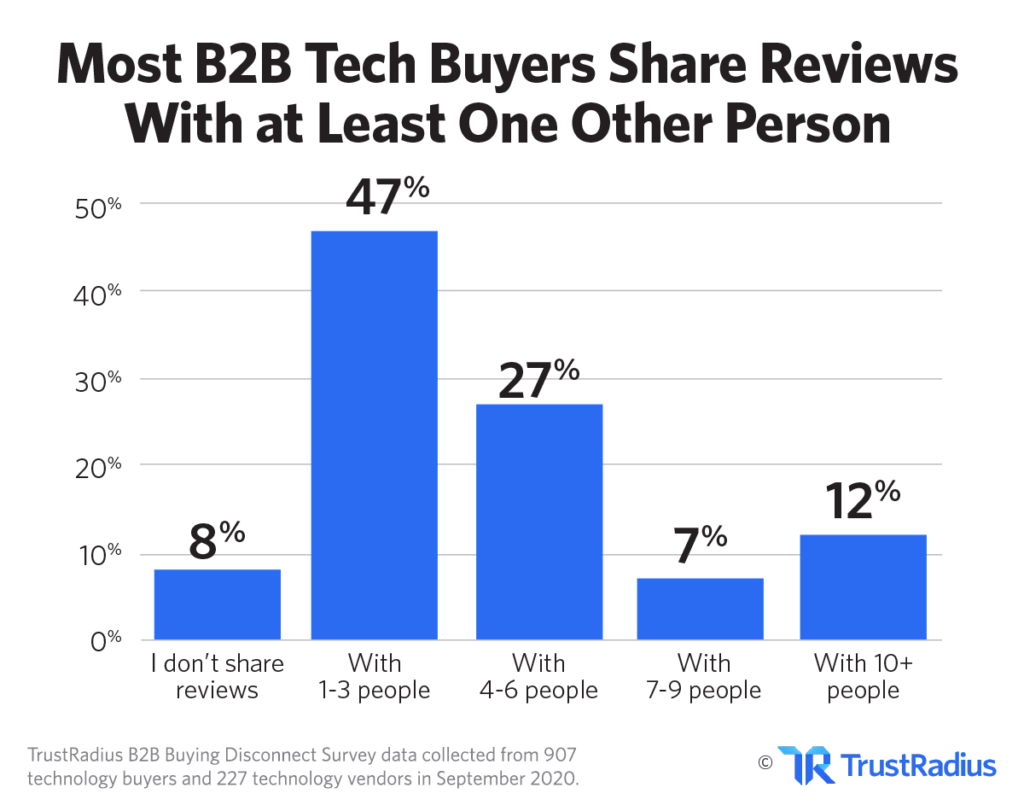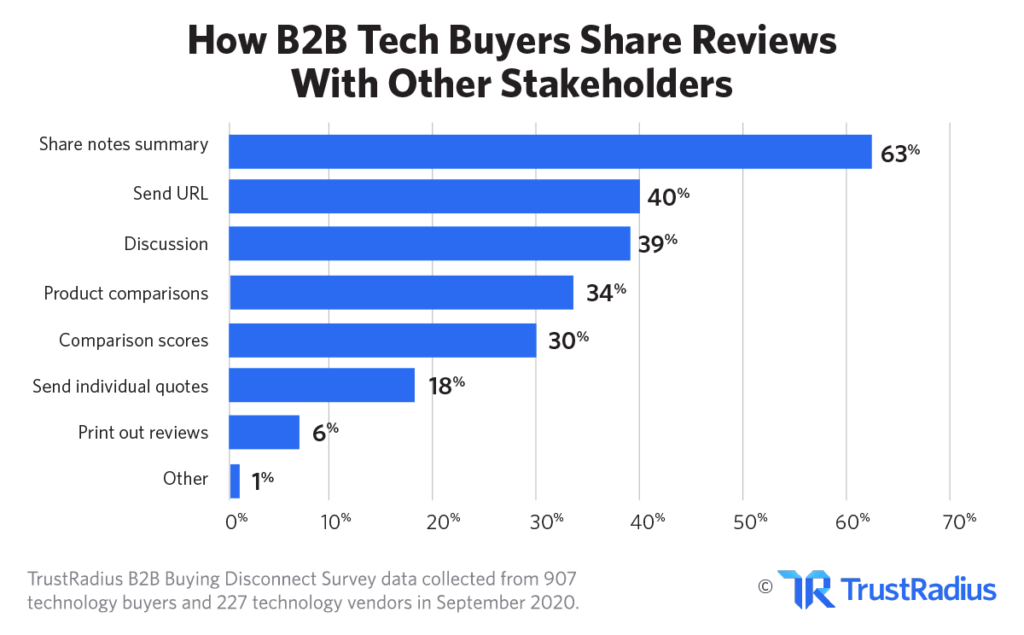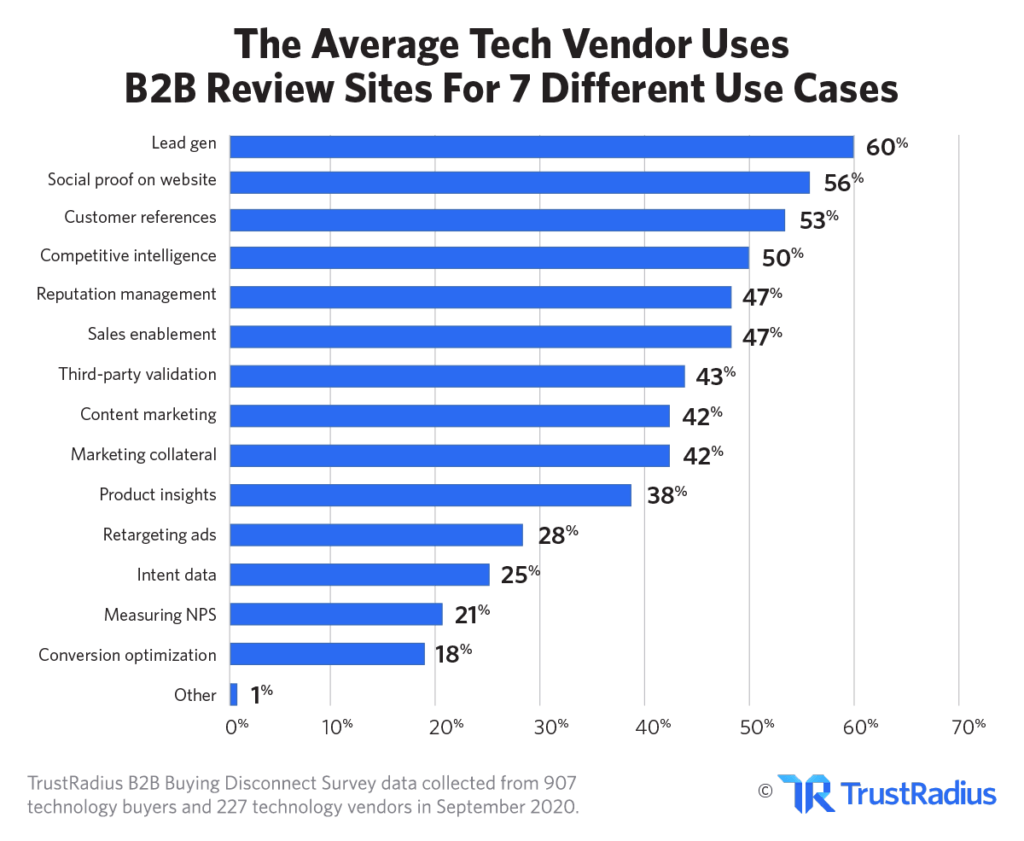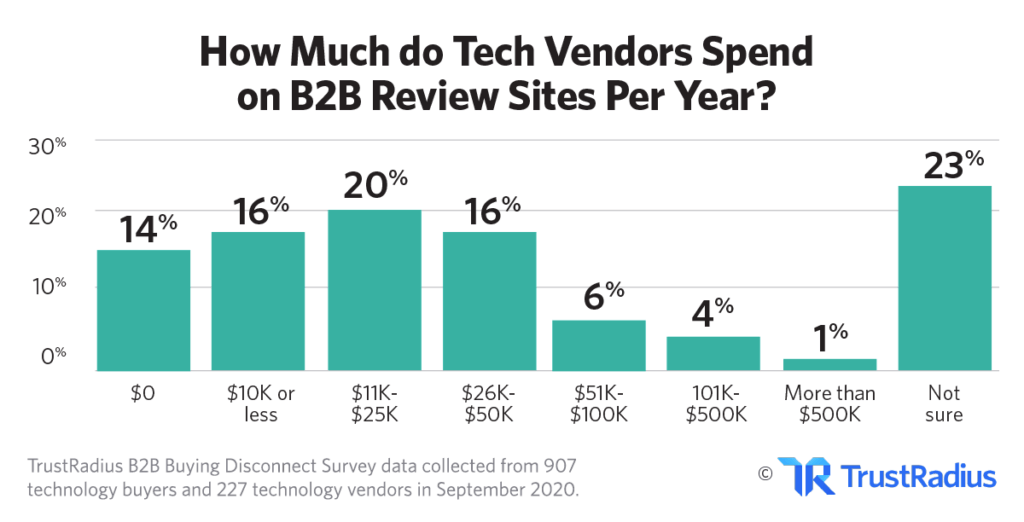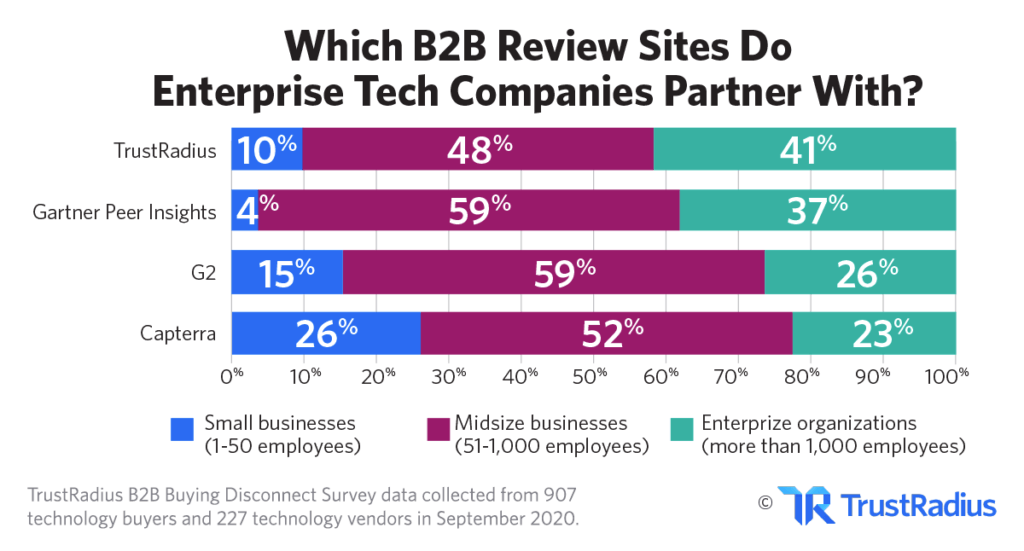The Marketer’s Guide to B2B Customer Reviews
Marketers, listen up: buyers don’t trust your marketing collateral. But they do trust B2B customer reviews.
Year over year, research shows that buyers rely on the same top five information sources to help them buy technology. Customer reviews are one of them. In 2021 more than 45% of buyers use customer reviews, and 92% of them share reviews with others.
That’s a huge potential opportunity—and new data from the TrustRadius 2021 B2B Buying Disconnect shows that B2B reviews matter now more than ever. According to buyers, they’re one of the most trustworthy and influential resources on the market.
This guide will help you create or level-up your customer review program so you can build trust with your buyers—and influence all the new buyers who will come across your brand this year.
Here are some major insights to explore:
What buyers care about on review sites
How influential customer reviews are in 2021
How successful marketers use customer reviews
How much a customer voice program costs
Which review sites are relevant for your business
Marketers Aren’t Sure What Buyers Care About on Review Sites
For demand generation professionals, the number one question is always: what do buyers actually want? When it comes to customer reviews, we’ve found the answer.
For the 45% of buyers who use reviews, the number one thing that matters on review sites is the review content—the long-form, qualitative feedback written by their peers.
More than a third of buyers who use reviews say that review content is the most important thing they look for. This is closely followed by finding reviewers they can relate to, like individuals from the same industry, company size, role, etc.
Buyers want to read long-form reviews from professionals like them. It’s that simple.
In contrast, tech vendors (mistakenly) assume that the most important factor is a product’s overall score or star rating.
Only 15% of the people who use reviews think that a product’s score is most important. Vendors underestimate the importance of review content by about 61%. They also inflate the value of a product’s score by about 2X.
Marketers tend to have a few other misconceptions about what matters to their buyers on review websites as well. For example, they undervalue the need for reviews from different personas—which is clearly very important to buyers. Vendors also place more importance on their total number of reviews than having recently published reviews. But our data shows that buyers care more about timely feedback.
Just because product scores aren’t the number one thing buyers care about, that doesn’t mean they’re not valuable. We know that scores are helpful for buyers as they compare products and build shortlists.
What’s interesting is that buyers don’t only want to read 5-star reviews. They want to sample the full spectrum of reviewer sentiment. On TrustRadius, some of our most popular review filters are for 1-star and 3-star reviews. Buyers are especially interested in 1-star reviews because they help them avoid pitfalls that other customers have experienced.
If you’re tempted to only invite your happiest customers to write reviews—don’t. Seriously, your buyers will thank you.
Customer Reviews are More Influential Than You Think
For those of you who are wondering just how much product reviews matter, the answer is more than you think.
B2B reviews have a certain “sphere of influence” based on how widely they’re shared. Of the buyers who said they use reviews during product selection:
- 92% share reviews with other collaborators.
- 45% share reviews or learnings from reviews with 4 or more other stakeholders.
- 12% of buyers share reviews with more than 10 other people.
The truth is, a single review can influence 10+ members of a buying committee at one of your top target accounts. Now imagine how much influence 20, 50, or 100 reviews could have.
Have you ever bought a new hundred-thousand dollar piece of technology on a whim? I bet the answer is no. Expensive investments are rarely impulse decisions, unlike in the consumer space.
In the B2B world, we’ve found that 95% of buying decisions are made collaboratively with other key stakeholders. In 2021, a majority (67%) of buying committees are made up of between 2-5 people. Only 4% of purchases are made by a single buyer. In collaborative settings like these, a single review can have an even greater influence on a purchasing decision.
The most common way that buyers share reviews with other stakeholders is by sharing a summary of their own notes from a review. It’s also common for buyers to share review URLs and start group discussions about review content.
The fact that a majority of buyers prefer to share reviews via their own notes shows just how highly engaged they are. For these buyers, review insights are crucial to their purchasing decision. Even though sharing a review URL is the easiest way to share a review, most buyers take the extra step of synthesizing review information in their own words.
Ultimately, a review’s ‘sphere of influence’ expands far beyond the first person who reads the review. If you’re wondering if you should invest in a voice of the customer program, this is a clear signal—your buyers are hungry for reviews and are ready to engage with them.
This is How Successful Marketers Leverage Customer Reviews
Wondering how to start running an online review management program? The first step is to make sure your products are listed across the most relevant review websites your buyers visit. The second is to start collecting reviews.
According to our latest survey, nearly half of vendors (46%) are already using reviews as a way to engage their buyers. They typically use reviews for lead generation, or as social proof on their websites, in sales enablement materials, and in email outreach. In fact, the average vendor using review websites leverages them for seven different use cases.
Many successful tech marketers have gone a step further. A large majority (86%) of vendors who use reviews choose to work with review websites in a paid capacity. And they make sure they get their money’s worth.
These marketers embed review sites deeply in their go-to-market strategy with more strategic use cases. Between 20%-25% of these marketers have expanded their use of review websites to include activities like:
- Capturing downstream intent data
- Collecting product insights
- Retargeting review site visitors
- Measuring net promoter score (NPS)
- Optimizing for conversion
If your B2B review program is already up and running, it’s time to level-up your usage of software review sites—starting with intent data. Learn more about how to use downstream intent here.
How Much Does a Voice of the Customer Program Cost?
The foundation of every good review program is free—it doesn’t cost anything to generate authentic reviews from your customer base. But working with review sites in a paid capacity can help you scale those efforts and give you access to more features and more valuable information about your buyers.
With a paid partnership, most review sites will also allow you to syndicate reviews directly onto your website landing pages—a strategy that has been proven to increase conversion rates. For example, Veeam was able to increase conversion rates on landing pages by 2%-12% simply by adding quotes from customer reviews on TrustRadius.
Of the 46% of vendors who use customer reviews as an engagement tactic, a large majority (86%) work with one or more review websites in a paid capacity. Only 14% report not investing in review websites.
So how much do tech marketers typically spend on review websites?
Looking at the 86% of technology vendors who pay to use review websites, about 1 out of 5 spend between $11K-$25K per year. To put that in context, $25K is less than the typical cost for a booth at a trade show or industry conference—both of which aren’t happening right now.
Looking at how much enterprise organizations (with 1,000+ employees) spend with review websites:
- About 1 out of 3 enterprise organizations spend upwards of $25K on their review strategy.
- Another 1 out of 5 enterprise organizations spend over $50K on their review strategy.
Compared to other marketing initiatives, review sites carry a seriously affordable price tag and therefore a higher chance for positive ROI.
To learn more about how TrustRadius can help you kickstart a voice of the customer program at your business, sign up for a demo of TrustRadius for Vendors here.
Deciding Between The Top Software Review Sites
Very few marketers take an all or nothing approach to customer reviews. In fact, we’ve found that many prefer to work with multiple review sites—because that’s where their buyers are.
One benefit of working with multiple software review sites is that different platforms cater to different audiences. Every review site attracts a different mix of SMB and enterprise buyers.
For example, TrustRadius is the most popular among enterprise organizations, while Capterra is the most popular among small businesses. At TrustRadius, between 40%-60% of our 1 million monthly users come from enterprise organizations. (Learn how to reach them through a partnership with TrustRadius.)
Because tech buyers look for reviews from people like themselves, in similar company sizes, industries, etc.—it’s important for tech marketers to consider this. Ask yourself “where are my buyers, and how can I reach them there?”
You want to look for software review sites where your buyers will be able to find people like them. If you’re interested to see what current customers think of working with TrustRadius, read user reviews here.
Level-Up Your Online Review Management Strategy
It’s easy to slip into the mindset that leads are the only thing that matters. But the intangibles like buyer trust, brand awareness, and market mindshare can matter even more than the sheer volume of leads you generate. That’s because those things influence how likely your leads are to convert into paying customers.
This is where B2B review sites shine—helping you improve trust with your buyers, increase brand awareness, and ultimately gain visibility in the market.
By partnering with review sites, you can monitor customer sentiment, see what problems your buyers are having, and leverage the voice of the customer to supercharge your sales and marketing engine.






